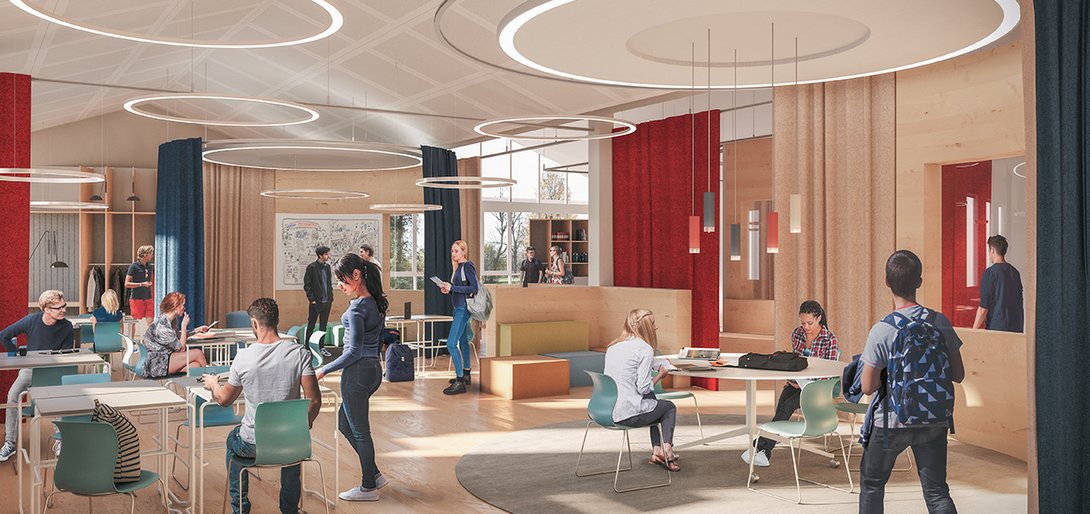Ready for the classroom of the future?
Long gone are the days of set group classes, conventional classrooms, separate subjects and timetables. Rather, pupils are learning independently, working on projects of their choosing in open educational and laboratory spaces with supervision by teachers. Is this the future of learning?
Dr Dr Dierk Suhr, head of education at the Waldner educational brand Hohenloher, knows all about these trends. As an expert for innovative STEM learning environments, he guides many schools through transformation processes and knows the latest developments in pedagogy, didactics and school architecture. “Schools such as the Stiftung Louisenlund are already enthusiastically trying out forward-looking learning methods. However, the pedagogical concept always ultimately determines how much on-site architectural innovation is possible or desired. Dismantling classrooms isn’t necessarily a great idea in and of itself, but it works if self-guided learning is the goal. If you want to replace the traditional chalkboard with a smartboard, you’re going to need digital didactic concepts as well.”
Suhr adds that open learning and laboratory spaces, too, only make sense when a school’s pedagogical vision calls for these kinds of innovative rooms. He also warns that these new freedoms, which may sound like paradise for current school pupils, also bring new challenges for educators: “At the end of the day, the teachers are responsible for incorporating relevant learning material into the individual projects.”
How do you know if it’s working?
Let’s start with the good news: modern educational approaches like self-guided learning consciously do not strive to cover everything. In the age of omnipresent information, pupils cannot and don’t have to know “everything”. Why should they? Knowledge is available at any time, and is probably being programmed to be more intelligent anyway. According to the future-oriented think-tank Zukunftsinstitut, it is more crucial that pupils learn to differentiate between real knowledge and unreliable information.
“The school administrators and teachers also need to move on from the idea that they can plan and structure everything in detail,” Suhr emphasises. In his view, learning that is project-based, networked, interdisciplinary, phenomenon-based, exploratory, research-focused and cooperative, as is common practice in STEM education, always calls for a certain amount of improvisation. “Thinking in terms of systems, conducting experiments, making things and trying them out independently – all of these activities naturally have no guaranteed results. Failure is an integral part of natural sciences and technology, since experiments and mistakes lead to innovation,” Suhr continues.
Time for 21st-century skills
The future has always been full of uncertainty, but our path forward has never been as dynamic and fast-paced as it is today. “That’s why learning for tomorrow needs to start in the here and now. Of course it doesn’t have to be as radical everywhere as it is at Louisenlund!”, says the expert on educational rooms. He names numerous other examples of successful, innovative education – including municipal schools both small and large, both established and new, in both cities and rural areas. “Children and young people need forms and methods of learning that allow them to develop the skills needed for the 21st century – especially since we have no idea what education, life or work will actually look like in ten or twenty years, or which occupations are going to be in demand in 2035,” Suhr explains.
According to labour market and education experts, the most important 21st-century skills will be creativity, critical thinking, collaboration and communication. In a world growing more digital, diverse and inclusive, we can add another “C” to the list: complexity, or being able to deal with it. The latter is projected to become the greatest challenge for society. And teaching and learning are no exception.
Doing away with outmoded homogeneity
Experts also criticise the outmoded idea of pupils forming a homogeneous group that can be taught using homogeneous teaching methods over years of schooling. “Language support, highly gifted pupils, ADHD: there’s more heterogeneity today than ever – and schools need to react accordingly!”, says Dierk Suhr of pupils’ increasingly diverse learning needs. He goes on: “For future-oriented learning, schools need to address this in every subject – in terms of both pedagogy and interior design – creating opportunities for both collaboration and individual development.” He mentions example measures such as rhythmic all-day school with alternating phases of social interaction and individual learning, rooms for both teamwork and independent learning, and the idea of doing away with set class groups in order to distribute pupils according to their needs in different subjects.
How we can prepare for the future
We need a new pedagogical vision for the education of tomorrow. To lay the necessary groundwork, schools need to succeed in promoting co-determination, self-guided learning and individual skills development; accepting heterogeneity and individuality; and imparting 21st-century skills and the joy of learning. The more digital, inclusive and diverse the future becomes, the more crucial it becomes to learn how to deal with complexity.
One clever strategy for handling complexity is to reduce a problem down to its essential elements. You can simply get rid of anything that is no longer relevant for the new learning requirements. That might be a separating wall – or even the entire class group structure and timetable, as at Louisenlund.
Get inspiration for your own school vision
The future may tend to reach German schools more as a gradually rising tide than as a sudden tsunami. However, many innovative elements for the education of today and tomorrow have already been developed and implemented in successful transformation processes. Sometimes across the entire school, sometimes concentrated in certain areas such as STEM fields. This can motivate and inspire us to rethink future learning! Architecturally as well, since rooms play an educational role and can promote or even enable modern learning techniques.
To learn more about how room concepts are developed based on pedagogy and didactics, you can take a look at our learning spaces site.

0 Comments
No Comments